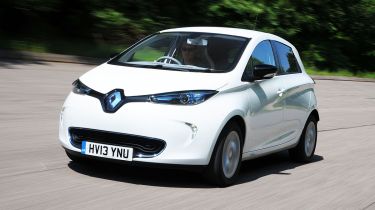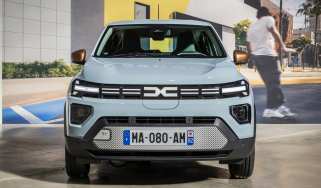Renault ZOE
Conventionally styled supermini makes a convincing case for itself
The new ZOE is the most convincing EV we’ve driven to date. Its looks and price are far more appealing than many electric rivals, and it drives better than the Leaf. The lack of a three-pin plug charging option is an issue, but Renault’s offer to fit free home chargers helps make up for this – provided you have the room for one.
No other manufacturer has committed so wholeheartedly to the electric vehicle as Renault. A handful of companies have a full EV in their range – and more have them in the pipeline – but the ZOE is the fourth model to join Renault’s ZE (Zero Emissions) line-up.
However, the ZOE is the most ambitious arrival yet, as Renault claims it “heralds a new era of electric mobility for all”. These are big words, but a smart five-seat battery-powered supermini certainly has the potential to attract customers previously deterred by quirky EVs like the Twizy.
The ZOE is based on the latest Clio platform and built alongside its more conventional stablemate in Flins, France. It also shares its battery technology with the Nissan Leaf. But with 60 new technology patents, the newcomer from Renault promises to be the most advanced EV we’ve seen from the Renault-Nissan alliance.
Used - available now

2024 Ford
Focus
23,066 milesAutomaticPetrol1.0L
Cash £16,897
2024 Vauxhall
Crossland
47,467 milesAutomaticPetrol1.2L
Cash £12,197
2020 Vauxhall
Corsa Electric
44,960 milesAutomaticElectric
Cash £9,499
2021 BMW
iX3
54,513 milesAutomaticElectric
Cash £19,209Yet for the most part, the ZOE looks just like an ordinary supermini – only the lack of an exhaust pipe or fuel cap gives away its electric drivetrain. With an almost identical wheelbase and width to the Clio, it’s a traditionally sized supermini, too.
However, as a result of packaging its batteries under the rear seats, the ZOE is much taller than traditional rivals – it’s almost as high as many supermini-MPVs. Elsewhere, the high shoulder line and narrow windows help heating or cooling efficiency by minimising the glass area.
Much of the interior – including the central part of the dashboard – is carried over from the Clio, but rather than the conventional instrument, you get a digital display that shows remaining range and speed. All trims get Renault’s R-Link tablet screen, which includes sat-nav and Bluetooth functionality, as well as downloadable apps.
Overall, the cabin design is modern and straightforward, but Renault has tried to create a techy ‘Apple shop’ feel by adding lots of shiny white trim and light materials to give it a bit of spark.
Unfortunately, the light trim creates reflections in the windscreen. Added to nasty A-pillar blindspots, this makes visibility a bit of an issue, while the driving position is partly compromised by the high-mounted seat.
On the plus side, the conventional gear selector and handbrake are refreshingly easy to use compared to the fiddly drive selector in the Leaf, and getting on the move couldn’t be easier – you simply power up, select drive and off you go.
Once you’re driving, the ZOE’s steering has a slightly more natural feel than the Leaf’s, but with 290kg of lithium ion batteries to carry around, the handling is inert compared to that of conventional superminis.
Having said that, mounting the cells low down means body control isn’t too bad, and the ZOE feels less nose-heavy than the Nissan. Plus, the ride isn’t quite as brittle. Like all EVs, the grabby brakes take some getting used to, and with less power than the Nissan, the Renault isn’t as quick off the line. If you do fancy flooring the throttle, the instant response will still raise a smile, but, above 60mph the ZOE soon runs out of puff.
Thanks to Renault’s novel Chameleon charger system, which works with single or three-phase power, the ZOE’s battery can be 80 per cent charged in as little as 30 minutes – although a full charge can take up to nine hours. When full, the car has an official range of 130 miles, although Renault admits that in the real world you’re more likely to manage between 60 and 90 miles.
Crucially, unlike the Leaf you can’t charge from a conventional three-pin domestic plug, although Renault will fit a charging station at your home for free. And depending on your annual mileage and contract length, battery hire will cost between £70 and £113 a month.
The ZOE also comes with Renault’s 4+ free servicing, roadside assistance and warranty package, while the electric powertrain is covered for five years. If you’ve got a charging point near you and mainly drive short distances, the ZOE is a tempting proposition.
2nd. Nissan Leaf Visia



